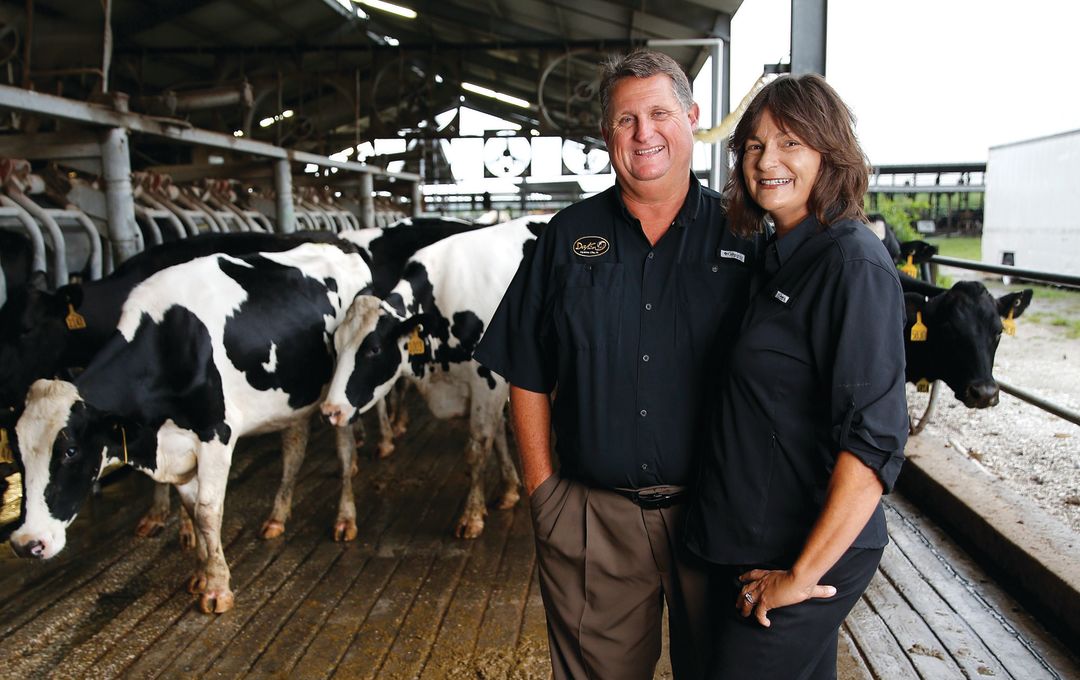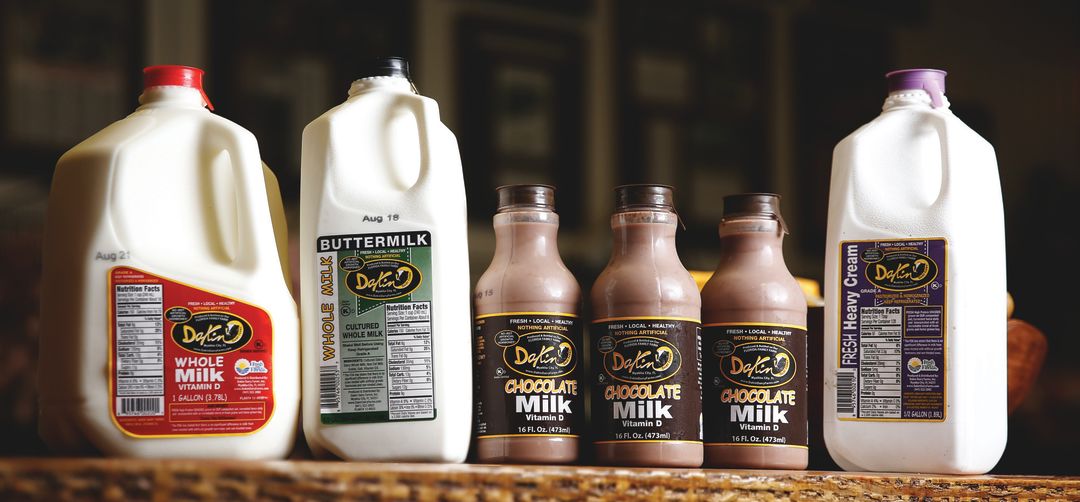Karen and Jerry Dakin Have Built a Diverse Agri-Empire at Dakin Dairy

Jerry and Karen Dakin
Image: Fred Lopez
Karen Dakin watches preschoolers on a field trip spilling out from the Dakin Dairy Farm Café, still excited about seeing real cows. They dart over to the adjacent oak hammock where a swing dangles from a branch and goats roam under trees. It’s the kind of scene that makes people want to give up their desk jobs and go into farming.
But Dakin Dairy Farms, owned and operated by Karen, 55, and her husband, Jerry Dakin, 48, is a sophisticated, challenging undertaking of five integrated corporations: a dairy farm, milk plant, a 700-acre dirt mining and compost operation, a realty division that handles property acquisitions and a department that manages agritourism operations. It’s one of only three remaining dairy farms in Manatee County. The other two—both boasting more than 1,500 milking cows—are owned by Karen Dakin’s brothers-in-law, whose father, Pete Dakin, began dairy farming in Manatee County in 1973.
Karen and Jerry Dakin are succeeding in a difficult industry. The high cost of land and equipment, tight financing, fickle weather, labor costs and market vagaries make farming a high-risk endeavor. Only 2 percent of Americans are directly involved with any sort of farming, according to the U.S. Department of Agriculture, making most of us reliant on a dwindling number of farmers. In 1935, there were 6.8 million farms in the United States. As of 2014, there were 2.1 million farms, 97 percent of them family-owned, according to the USDA.
With 1,200 acres, 5,000 head of cattle, 84 employees and their own milk bottling operation, Dakin Dairy Farms is one of the survivors. “In Florida, the cost to raise cows to milk is higher than any state except Hawaii,” Karen says. “It’s hard to be a small farmer down here. Can it be done? Yes, if you do the value added.”
Karen wouldn’t reveal revenues, but says the dairy, natural soils and bottling make most of their sales.
“[Revenues] are a moving target,” she says. “Milk is a commodity, not a niche product. You can lose on one end and gain on another. Last year, milk prices were up for the farmer, which made it a challenge for the plant to make any respectable amount of money or even break even. So the dairy was doing well, but the plant was struggling. This year, flip the table.”
This fall, the Dakins are poised to launch their latest venture: cheesemaking. The couple has converted a 40-foot by 25-foot space next to their bottling plant, invested in a $250,000 stretching machine and brought in a master Italian cheesemaker to help them develop a unique in-house cow’s milk mozzarella with authentic cultures from Italy that the public can sample during the farm’s season opening festival in October. Already, 8-ounce balls are going out for trial to their distribution base.

Image: Fred Lopez
Cheesemaking was one of Karen’s first dreams when they bought this property. She’s a cheese lover, sure, but she saw an opportunity. “Cheese is highly consumed by restaurants and fits with our distribution. The restaurants buy cases and cases of cheese every few days,” she says.
And the price was right. A buffalo milk mozzarella maker in Clearwater went out of business when an entire container of buffalo curd got held up at the port and spoiled. The cheesemaker hadn’t been in business long enough to withstand the loss, and the Dakins were able to purchase his equipment for dimes on the dollar. Karen says she’s unsure about whether they’ll command significant returns on the investment—mozzarella is a competitive product—but it’s an opportunity. As her father-in-law used to say, mistakes are “tuition.” Karen approaches her decisions this way: “You ask, ‘What’s the worst case scenario and can I live with it?’”
Nearly three decades ago, Karen, a newly divorced single mother, decided she couldn’t live with her 60-hour workweeks at the telecommunications firm she co-owned. She bought 10 acres in Parrish where, armed with books, research and frequent calls to experts, she began growing onions. Six months of calling restaurants paid off when one offered to buy arugula, basil and parsley if she would grow them. “I was coming up with significant, serious dollars every week, but it was seasonal,” she recalls. So she got her real estate license. Providentially, it was the 1990s, and Panther Ridge on State Road 70 was just kicking off. “I was their first sales rep,” says Karen. She sat under a tent selling lots, and spent weekends writing contracts and managing her little plot of farmland.
While she was selling those herbs in Parrish, Karen met Jerry Dakin, the son of a longtime Manatee dairy farmer, at a feed store. The two began dating, and even when evenings out took unexpected turns—such as the date that ended with Karen holding a pregnant cow in an indelicate position while Jerry pulled the calf out—Karen knew farm life was her future. She views her outsider status as an asset. “It’s fresh eyes looking at the same stuff,” she says. “The first time I went on the farm, all everybody could see was manure. All I could see was compost.”
After the couple married, they bought their first 250 head of cattle from Jerry’s parents, who were ready to retire. When the newly minted dairy owners went looking for a property to buy, however, they came up short for the 25 percent down they needed for the land. A group of farmers developing a property called Sundance Trails in Hillsborough County approached the Dakins and offered to sell them the development with owner financing. Within four years, doing all the work themselves, they had cleared the mortgage, sold all the plots and had made enough money to head back south to Manatee County and make a down payment on the Myakka City acreage they had originally eyed.
They bought more cows and added more land. They traveled around the country, studying sustainable farming practices and brainstorming how to bring them to Florida. They enrolled in courses and seminars. Seven years ago, they did something radical for a dairy farm: They began to bottle their own milk. “[We were] stepping outside the protected comfort zone of a co-op picking our milk up every day on time and guaranteeing a paycheck,” says Karen. “There’s a certain amount of protection in that. Your milk has a market. The radical thing is the expense to build a milk bottling plant.”
While most milk plants do 90,000 gallons a day, the Dakins do 90,000 gallons a week, a challenging amount because 90,000 gallons a week is large enough to make selling a challenge, but small enough so they can’t take advantage of volume to compensate for the low commodity price.
At first, Karen had to give pallets of milk away to distributors, stores and restaurants to get them to take her product. Now, she’s in Whole Foods statewide, several Latin grocery stores in Miami, local restaurants and 14 Winn Dixie stores. The gamble paid off for two reasons, she says, the rise in demand for local foods and the quality of their milk.
The Dakins also learned how to turn disadvantages of Florida farming—heat and sandy soil—into advantages. Sloping, sanded barn floors help wash the cow’s manure into a settling basin, where it is composted and put back in the ground to grow more protein-rich grass. The grass is blended with hay in a formula created by a nutritionist to create an optimal, all-natural diet for the cows. The sand is cleaned by the sun and reused for cow bedding in the farm. As for the extra compost? It’s sold by one of their enterprises, Dakin Natural Soils. Their buyers are wholesale landscapers.
Nearly eight years ago, the Dakins began offering tours, field trips, hosting birthday parties and events and serving customers at a souvenir farm stand and restaurant. They were ahead of the agritourism trend, which was just beginning to pick up nationally. By 2012, agritourism and on-farm operations such as fishing and hunting were netting $704 million nationally, a figure up 24 percent since 2007, according to the USDA. Today, between 10,000 and 15,000 people pay $15 each to visit Dakin Dairy Farms every year.
Agritourism has not been a financial quick-fix. The Dakins spend $25,000 just to advertise in main venues. It would cost nearly $80,000 in marketing to get their agritourism business to a point of significant returns and quick turn-around, she says.
It also took four years just to figure out the right mix of merchandise for the gift shop, and employees had to be hired to run the tours and staff the shop and café. "It's actually a labor of love,” she says. “It allows the public to come onto a farm for education. And it promotes our brand name. ‘Come see who we are. Come see how we treat our cows, and how we feed our cows.’”
And now that her mozzarella is well under way, Karen Dakin has methane on her radar. There’s more than one use for all that manure, she says—and she’s prepared to delve into the ins and outs of making electricity from that enterprise.
“I’m a project person,” she says.



